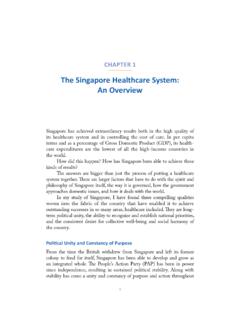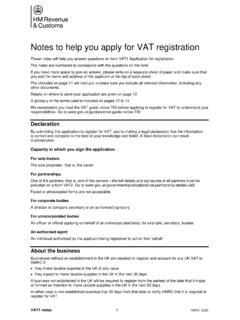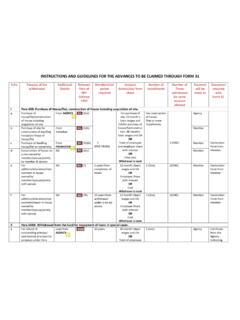Transcription of A guide to mutual ownership models - GOV.UK
1 A guide TO mutual ownership models NOVEMBER 2011 A guide to mutual ownership models What is a mutual ? The term mutual is used as an umbrella term for several different ownership models . Mutuals are often described as being characterised by the extent to which members have democratic control of the business and share in its profits, and contrasted with investor controlled companies. However, this is a misleading distinction, because all limited companies operate for the benefit of their members the shareholders who invest in a company limited by shares, or the guarantors of a company limited by guarantee and these members are involved in control of the business whether directly, or through scrutiny of the actions of the directors, or simply by buying and selling shares in response to the company s performance.
2 The distinguishing characteristic of a mutual is that the organisation is owned by, and run for, the benefit of its members, who are actively and directly involved in the business whether its employees, suppliers, or the community or consumers it serves, rather than being owned and controlled by outside investors., Legal structures for mutual ownership It is important to note that legal structure is not the same as ownership model mutuals can be based on a variety of different legal structures.
3 For example, the flexibility of the limited company structure means it is possible for companies to operate a mutual ownership model. But it is also true that partnerships and limited liability partnerships are essentially mutual the partners own and run the business for their own benefit. There is also an incorporated legal structure which is specifically mutual : the industrial and provident society . There are two types of these: Co-operative Societies and Community Benefit Societies (BenComms).
4 Co-operative Societies operate for the benefit of their members, and distribute any surplus not reinvested in the business to those members. BenComms conduct business for the benefit of their community. Any profits are not distributed among members, but returned to the community. They therefore provide a legal structure designed for social enterprise. Industrial and provident societies always have a mutual ownership structure. The term Co-operatives describes a wider movement of mutual enterprises, which includes all Co-operative Societies and Community Benefits Societies.
5 However, not all co-operatives use these legal structures many are in fact limited companies. For more information about co-operatives, see below. 2 Employee-owned companies If a limited company is more than fifty percent owned by its employees it is usually described as employee-owned . Where employees hold a significant stake in a company, but less than fifty percent, this is often referred to as co- ownership . There are two main types of employee ownership : direct employee ownership where employees become individual shareholders of shares in their company indirect employee ownership where shares are held collectively on behalf of employees, often through an employee trust.
6 Many companies, including many large public companies (listed or otherwise), operate employee share ownership plans using one or more tax advantaged share schemes to allow either all or some of their staff to own shares in the company they work for. Indirect employee ownership via an employee trust is a commonly used model by employee-owned businesses. It is a way of enshrining employee ownership in the business for the long term via the rules of the trust. It is also possible to combine direct and indirect ownership a combination of individual and collective share ownership .
7 Co-operatives The term co-operative is defined by the International Co-operative Alliance as an autonomous association of persons united voluntarily to meet their common economic, social and cultural needs and aspirations through jointly owned and democratically controlled enterprise . To be a co-operative, the enterprise must reflect the following co-operative values set out by the International Co-operative Alliance, namely: self help, self responsibility, democracy, equality, equity, and solidarity.
8 Co-operatives must also reflect four ethical values: honesty, openness, social responsibility and caring for others. They must also subscribe to the following set of co-operative principles: voluntary and open membership, democratic member control, member economic participation, autonomy and independence, provision of education, training and information, co-operation among co-operatives, and concern for community. There are a number of different types of co-operative, these include: worker co-operatives, - these effectively operate a system of 100% employee ownership consumer co-operatives - where members are the customers of the business 3 producer co-operatives - where members are independent producers who form a consortium, often to reduce fixed costs such as distribution or marketing community co-operatives drawing their members from a local community (or a community of people with a common interest)
9 Some co-operatives may of course have more than one membership type. The term co-operative does not itself refer to a specific legal form. Many co-operatives are industrial and provident societies (either co-operative societies or community benefit societies), but it is not necessary to use this legal form to be a co-operative: many co-operatives are in fact companies usually limited by guarantee. Because of the values and principles of the co-operative movement, many co-operatives are social enterprises that is they have primarily social objectives and reinvest or use the majority of their profits for those objectives.
10 Such enterprises may use a standard co-operative society or company legal structure. Alternatively they may adopt a legal structure designed for social enterprise either the community interest company (CIC) or the community benefit society . The benefits of mutual ownership mutual ownership models will not be appropriate for all businesses. However it is clear that mutual models can form the basis for high performing, profitable businesses and deliver genuine business advantage. Evidence suggests for example that mutual ownership can help to ensure that decisions are focused on the long term sustainability of the business.













